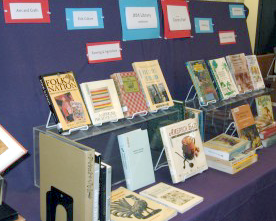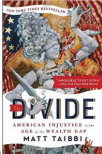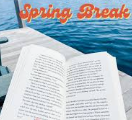The books of the 2016 Summer Reading List are now on display on the first floor of the Library!!
What is the Summer Reading List? Your friendly Chatham University Librarians have been keeping an eye out for interesting, informative, and exciting books over the
past year and thought you might enjoy reading some of these as you start your first year at Chatham. Featuring popular nonfiction, as well as some great literature, this list
contains something for everyone! Find the full 2016 Summer Reading List here!
Some highlights of the List include:
Tattoos: Philosophy for Everyone: I Ink, Therefore I Am by Robert Arp
Body art or eyesore, a celebration of individuality, or at very least a conversation piece, tattoos provide fertile ground for philosophical discussion, raising intriguing
questions from aesthetics to feminism, from semiotics to the philosophy of the person.
The Evolution of a Corporate Idealist: When Girl Meets Oil by Christine Bader
The Evolution of a Corporate Idealist: Girl Meets Oil is based on Bader’s experience with BP and then with a United Nations effort to prevent and address human rights
abuses linked to business. Using her story as its skeleton, Bader weaves in the stories of other “Corporate Idealists” working inside some of the world’s biggest and bestknown companies.
How to Do Things with Videogames by Ian Bogost
Until games are understood to have valid applications across the cultural spectrum, their true potential will remain unrealized. How to Do Things with Videogames offers a
fresh starting point to more fully consider games’ progress today and promise for the future.
It’s Easy Being Green: A Handbook for Earth-Friendly Living by Crissy Trask
It’s Easy Being Green is a handy tool to help you make better choices for the environment. This is what the busy person needs to start making changes today. Get
informative, comprehensive and practical information for adopting greener buying habits and identifying earth-friendly products; shopping for green products online;
participating in online activism; and learning from over 250 eco-tips for cultivating a sustainable environment.
Half a Lifelong Romance by Eileen Chang; translated by Karen S. Kingsbury Shanghai, 1930s. Shen Shijun, a young engineer, has fallen in love with his colleague, the beautiful Gu Manzhen. He is determined to resist his family’s efforts to match him with his wealthy cousin so that he can marry her. But dark circumstances—a lustful brother-in-law, a treacherous sister, a family secret—force the two young lovers apart…A glamorous, wrenching tale set against the glittering backdrop of an extraordinary city, Half a Lifelong Romance is a beloved classic from one of the essential writers of twentieth-century China.
On Writing: A Memoir of the Craft by Stephen King
Stephen King reflects on how his writing has helped him through difficult times and describes various aspects of the art of writing.
Book of Rhymes: The Poetics of Hip Hop by Adam Bradley
Examining rap history’s most memorable lyricists and their inimitable techniques, literary scholar Adam Bradley argues that we must understand rap as poetry or miss the vanguard of poetry today. Book of Rhymes explores America’s least understood poets, unpacking their surprisingly complex craft, and according rap poetry the respect it deserves.
A Short History of Nearly Everything by Bill Bryson
In this book Bill Bryson explores the most intriguing and consequential questions that science seeks to answer and attempts to understand everything that has transpired from the Big Bang to the rise of civilization. To that end, Bill Bryson apprenticed himself to a host of the world’s most profound scientific minds, living and dead.
Crazy: A Father’s Search through America’s Mental Health Madness by Pete Earley
Former Washington Post reporter Pete Earley had written extensively about the criminal justice system. But it was only when his own son-in the throes of a manic
episode-broke into a neighbor’s house that he learned what happens to mentally ill people who break a law. This is the Earley family’s compelling story, a troubling look at bureaucratic apathy and the countless thousands who suffer confinement instead of care, brutal conditions instead of treatment, in the ‘revolving doors’ between hospital and jail.
The Quartet: Orchestrating the Second American Revolution, 1783-1789 by Joseph J. Ellis
From Pulitzer Prize–winning American historian Joseph J. Ellis, the unexpected story of why the thirteen colonies, having just fought off the imposition of a distant
centralized governing power, would decide to subordinate themselves anew. In 1776, thirteen American colonies declared themselves independent states that only
temporarily joined forces in order to defeat the British. Once victorious, they planned to go their separate ways. The Quartet is the story of the second American founding and of the men most responsible—George Washington, Alexander Hamilton, John Jay, and James Madison.
Commenting on blog posts requires an account.
Login is required to interact with this comment. Please and try again.
If you do not have an account, Register Now.
The summer reading list for first-year Chatham students has been posted! The contents of the list were chosen by your friendly neighborhood librarians, and include entries from different subject areas. There’s something on this list for everyone (and several things that I’ll be adding to my own summer reading list). Here’s a preview of some of the titles; make sure to access the complete list to see some other choices.
The Divide: American Injustice in the Age of the Wealth Gap Matt Taibbi
In the wake of the 2008 financial crisis and the Occupy movement, The Divide focuses on the myriad ways that wealth—or lack thereof—affects the rights afforded to US citizens (as well as the way this system impacts the immigration debate). Mass incarceration, stop-and-frisk, and the contemporary landscape of the US justice system provide evidence for Taibbi’s portrayal of a system that privileges wealth above all else.
Eating Together: Food, Friendship, and Inequality Alice P. Julier
What is the social impact of shared meals? Julier (director of the Master’s program in Food Studies here at Chatham) writes about the intersection of social eating experiences and social inequality, examining the literal and figurative aspects of who has a seat at the table.
The Fever: How Malaria Has Ruled Humankind for 500,000 Years Sonia Shah
The Fever addresses malaria as a subject with various historical, scientific, and socio-political resonances. Alongside anecdotal evidence of the way the disease is approached and conceived of in malaria-afflicted areas, Shah takes on the ineffectual attempts of various global organizations to curb its effects. The Fever offers a deeper understanding of the way malaria has shaped and continues to affect human history.
Citizen: An American Lyric Claudia Rankine
From microaggressions to overt racial violence, Citizen addresses life in “post-race” America. Rankine meditates on the ways that this constant narrative of otherness impacts daily life and, in some cases, even personal safety. Composed of prose poems, verse, essays, and images, Rankine’s work is a form-agnostic witness account of
contemporary race and racism in America.
The Signal and the Noise: Why So Many Predictions Fail—But Some Don’t Nate Silver
Silver takes on the art and science of forecasting, analyzing the various reasons—from a mastery of statistics to a healthy understanding of uncertainty—why some predictions are successful while others are not. The Signal and the Noise investigates forecasting from multiple vantage points, using examples of correct and incorrect predictions from sports, politics, economics, and more.
Source: Music of the Avant-garde, 1966-1973 Edited by Larry Austin and Douglas Kahn
This volume reproduces issues of the avant-garde periodical Source, which published a variety of experimental music bits and pieces. Introductory material provides some historical context, followed by the downright weirdness of the content itself, with pieces from John Cage, Morton Feldman,
Steve Reich, Nam June Paik, Harry Partch, and others.
The Paris of Appalachia: Pittsburgh in the Twenty-First Century Brian O’Neill
An affectionate tribute to Pittsburgh that also deals some tough love in response to some of the city’s ongoing problems. O’Neill includes the stories of Pittsburgh natives in his analysis, attempting to capture the character of a city situated somewhere between the East Coast and the Midwest both in terms of physical location and regional character.
Commenting on blog posts requires an account.
Login is required to interact with this comment. Please and try again.
If you do not have an account, Register Now.
Get out and explore the city this summer with inspiration from one of the books displayed on the First Floor.
Whether you’re interested in art, architecture, or the culture of Pittsburgh, you’ll find a helpful guide to your summer adventures.
Dates to the biggest festivals and events around the city will be posted in the Lobby for your convenience.
Find something that peaked your interest? Make sure to ask a librarian about how you can find more books about the Steel City!
Commenting on blog posts requires an account.
Login is required to interact with this comment. Please and try again.
If you do not have an account, Register Now.
Spring break is just a few short days away, so you better stop by JKM Library to check out the books on your Spring Break Reading List! Don’t have a list prepared?
Have no fear…the Popular Reading Display has just been stocked!
Here’s what’s new on the table:
Pittsburgh Noir, edited by Kathleen George
The Autumn House Anthology of Contemporary American Poetry, edited by Sue Ellen Thompson
Inside by Alix Ohlin
Dancing on the Edges of Knives, poems by Ed Ochester
Allegheny, poems by Ed Ochester
Invisible Monsters by Chuck Palahniuk
Wicked and Son of a Witch, by Gregory Maguire
Prodigal Son, by Dean Koontz
The Pittsburgh Book of Contemporary American Poetry, edited by Ed Ochester and Peter Oresick
Commenting on blog posts requires an account.
Login is required to interact with this comment. Please and try again.
If you do not have an account, Register Now.
Commenting on blog posts requires an account.
Login is required to interact with this comment. Please and try again.
If you do not have an account, Register Now.

Taking classes over the summer? The JKM Library is open the same hours during the summer as we are duringthe school year:
Monday – Thursday: 7:45am – 12am
Friday: 7:45am – 7pm
Saturday: 8am – 7pm
Sunday: 12pm – 12am
We’ll be closed on:
Monday, May 28 for Memorial Day
Wednesday, July 4th
Commenting on blog posts requires an account.
Login is required to interact with this comment. Please and try again.
If you do not have an account, Register Now.
 July 2011
July 2011
July is summer time! July also is the month holding interesting
national “holidays” including national grilling month, national hotdog month, and national blueberry month.
Upon discovering this, the first thing that came to my mind was another summer tradition – county fairs.
County fairs differ from state fairs not only in size but in activities. County fairs are much more like local
carnivals celebrating local craft, culture and food, while state fairs tend to be more competitive with more
emphasis on best-in-show livestock and produce. County fairs are where you will find pie eating contests,
handmade arts and crafts, entertainment, and lots of local foods.
County fairs date back to the mid 18th
century growing out of the need for people to buy and sell livestock and
other goods. The first designated place for an annual fair was in Trenton county New Jersey in 1745. The fairs
later included horse shows, carnival rides, music and dancing. As an agricultural state Pennsylvania has county
fairs throughout the summer all over the state. Butler County claims the largest, while York County claims the
oldest.
Obviously, the fair as community gathering place can be traced back through civilization, but here we celebrate
the American popular traditions and folk culture. (For an interesting and concise history, see “Circus and
Carnival” in Dictionary of American History, vol. 2). We also want to celebrate American food! Yes, of course,
that kind of American food, but also the kind that comes from your local farms, backyards, and communities. In
the past and present, we want to celebrate the women who cooked it and the land it comes from. We want to
celebrate potters and wood carvers, teachers and storytellers, entertainers and urban homesteaders.
While modern American folk culture is unique in its own right, it must be remembered that Native Americans
and African Americans were largely delegated to their own fairs. Not until the mid 20th
century were fairs openly
integrated, but the influence of both cultures are obvious in the crafts and cooking of European Americans.
America’s diversity can be recognized in different regions of the country, where fairs exhibit the flavor of their
locality. Check out the library’s display for books on the Pennsylvania region as well as national American
cooking, farming, gardening, crafts, and culture.
~Display and blog post by Donna Guerin, Reference Associate







The JKM Library and the Archives & Special Collections are pleased to present Chatham Summers with the University Archives, a media exhibition highlighting the rich documentation in our photographic collections. Items on view document life at Chatham during the summer and feature images of campus sports, events, and more. Lantern Slide Depicting PCW Tennis, c. 1905 The exhibit includes visual material from Chatham’s earliest years and from more recent years. 1888 Sketch of Students Wearing Sun Protection Though things may seem a bit quieter around campus than during the fall and spring semesters, these images reveal that Chatham students have always pursued a wide variety of activities, regardless of the heat, humidity, or era. We’ve included a few of our favorites in this post, but stop by the JKM Library to view the exhibit in its entirety! Taking a Spin Around Campus, c. 1952-1953 Diving Practice, c. 1950s Chatham vs. Robert Morris, 1980 Not around campus? Additional records from Chatham history, including yearbooks, newspapers, photographs, and other records are accessible online at the web site for the University Archives & Special Collections. Or, stop by the Archives Reading Room to learn more about Chatham history.
Commenting on blog posts requires an account.
Login is required to interact with this comment. Please and try again.
If you do not have an account, Register Now.